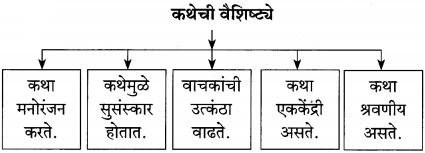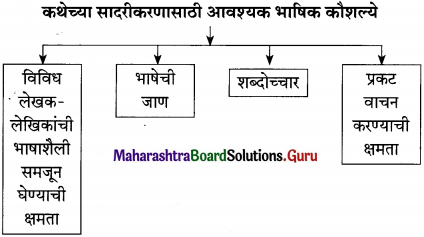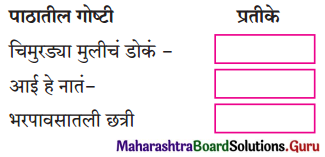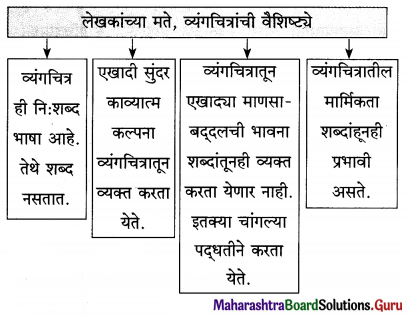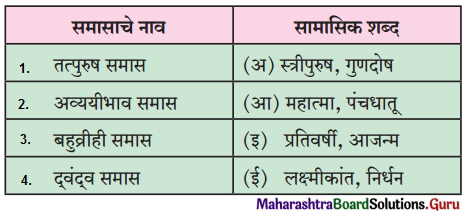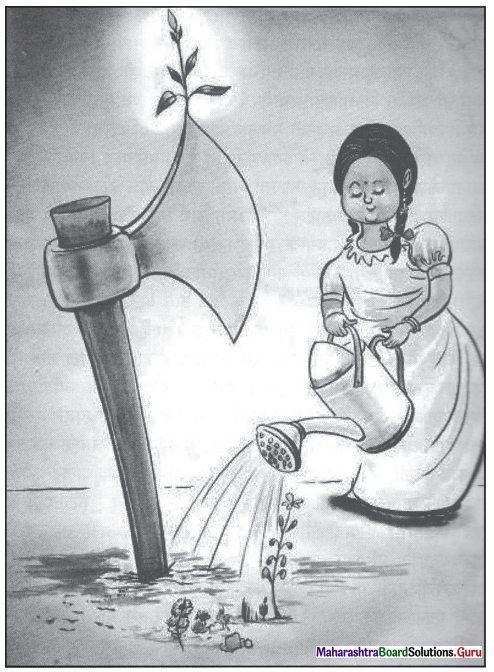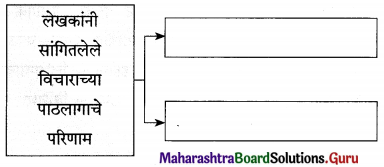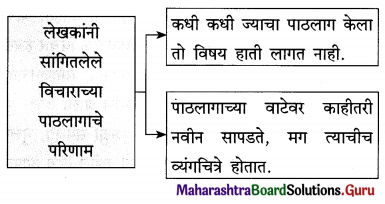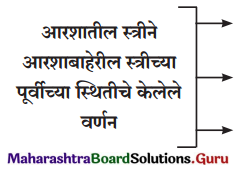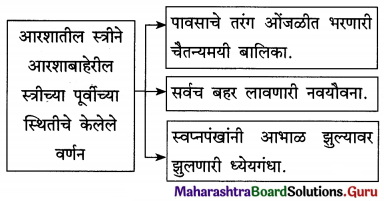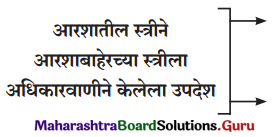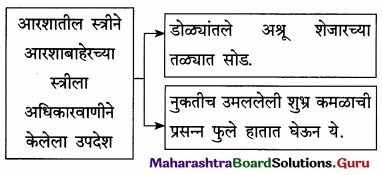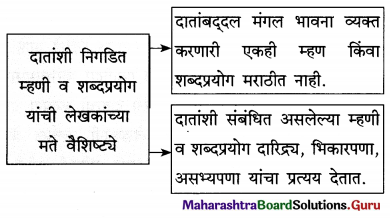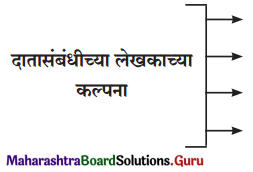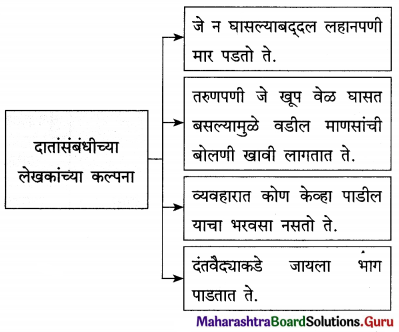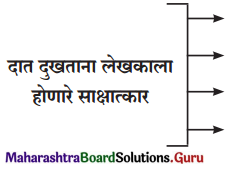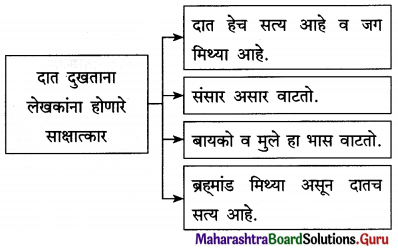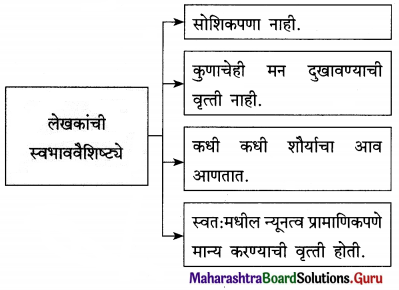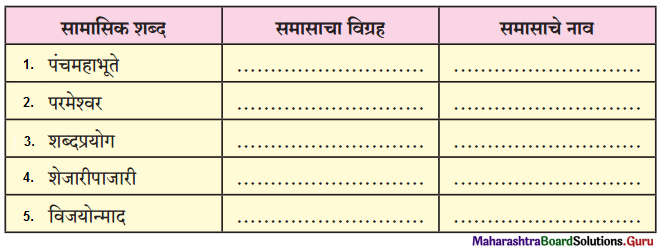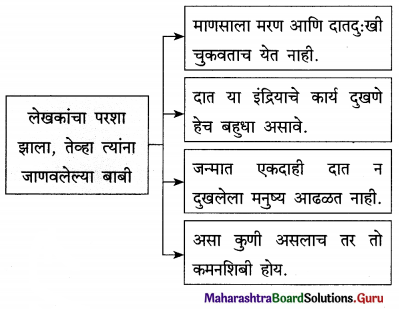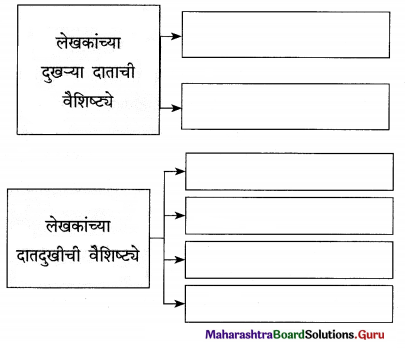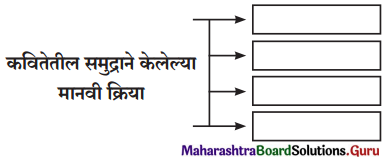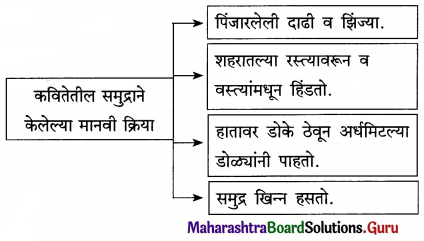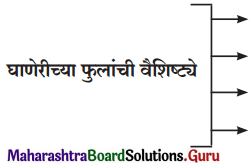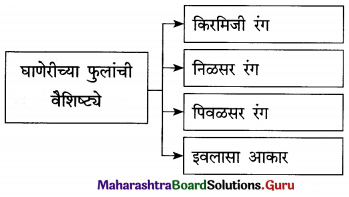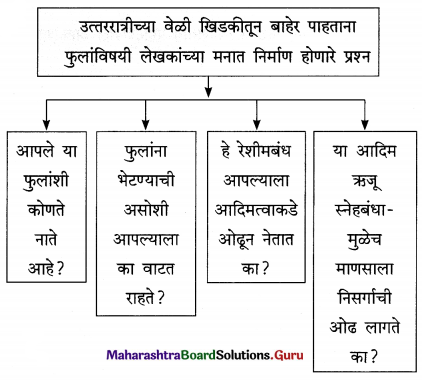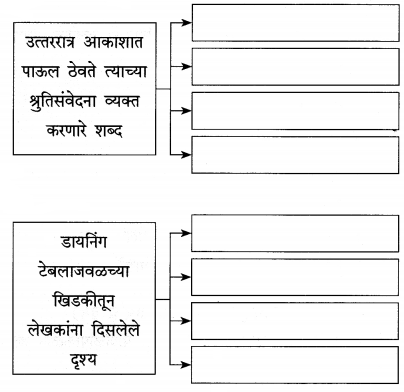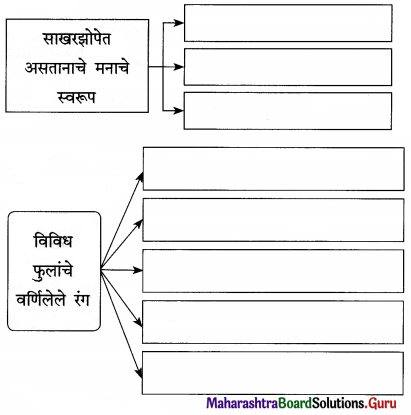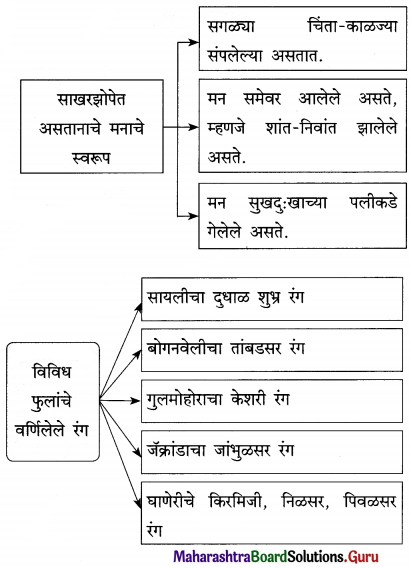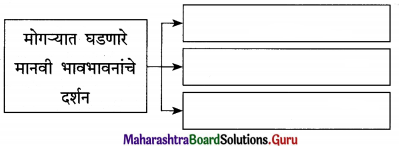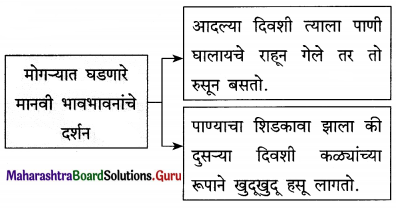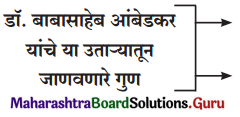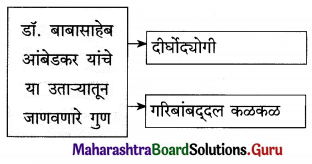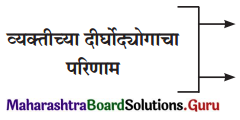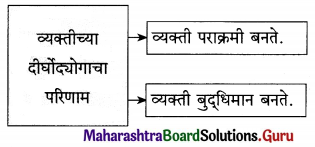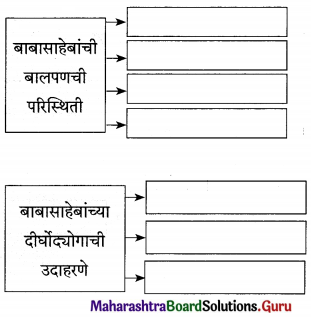Balbharti Maharashtra State Board Marathi Yuvakbharati 12th Digest Bhag 3.1 शोध Notes, Textbook Exercise Important Questions and Answers.
12th Marathi Bhag 3.1 Exercise Question Answer Maharashtra Board
शोध 12 वी मराठी स्वाध्याय प्रश्नांची उत्तरे
12th Marathi Guide Chapter 3.1 शोध Textbook Questions and Answers
कृती
1. (अ) कारणे लिहा.
प्रश्न 1.
अनुनं घर सोडलं, कारण…
उत्तर :
अनूने घर सोडले; कारण पाच वर्षे तरी तिला स्वत:ची म्हणून जगायची होती.
![]()
प्रश्न 2.
‘जगाकडं पाहताना मला माझा चष्मा हवा’, असं अन् म्हणाली. कारण…
उत्तर :
“जगाकडे पाहताना मला माझा चष्मा हवा,” असे अनू म्हणाली; कारण प्रत्येक वस्तूचे, घटनेचे, व्यक्तीचे मूल्यमापन करण्यासाठी तिला तिची स्वतंत्र नजर तयार करायची होती.
प्रश्न 3.
अनुने डॉक्टर व्हावे असे आबांना वाटत होते, कारण…
उत्तर :
अनूने डॉक्टर व्हावे, असे कथानिवेदकाला वाटले; कारण तिची कॅलिबर डॉक्टर होण्याची होती.
(आ) खालील नातेसंबंध लिहा.
(a) अनु आणि आबा ………………………….
(b) भिडे दाम्पत्य आणि टॅक्सी ड्रायव्हर ………………………….
(c) अनु आणि सुनीता ………………………….
उत्तर :
(a) अनू आणि आबा – मुलगी व वडील.
(b) भिडे दाम्पत्य आणि टॅक्सी ड्रायव्हर – प्रवासी व टॅक्सीवाला.
(c) अनू आणि सुनीता – नर्स व रुग्ण,
2. कृती करा.
प्रश्न 1.

उत्तर :

प्रश्न 2.
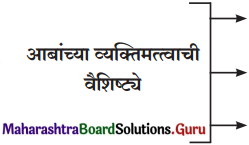
उत्तर :
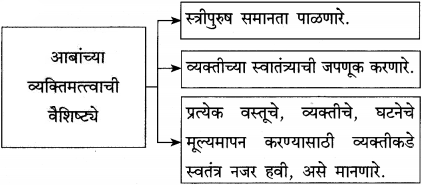
![]()
3. अनुने आबांजवळ व्यक्त केलेल्या विचारांतून डॉक्टरचा पेशा आणि नर्सचा पेशा यांतील फरक स्पष्ट करा.
उत्तर :
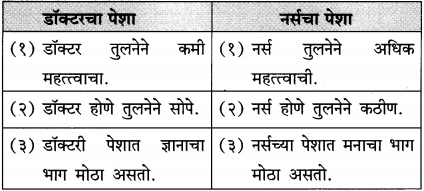

4. थोडक्यात उत्तरे लिहा.
प्रश्न अ.
घर सोडण्यामागचा अनुचा विचार तुमच्या शब्दांत स्पष्ट करा.
उत्तर :
अनूच्या मते, माणसे परंपरेने कुणाच्या ना कुणाच्या कलाने चालण्याची सवय लावून घेतात. जन्मल्यापासून आईवडिलांच्या प्रभावाखाली वागतात. प्रत्येकाला स्वतंत्र मेंदू मिळालेला असतो. पण माणसे दुसऱ्याच्या मताने वागतात. यामुळे माणसे स्वत:चे स्वतंत्र अस्तित्व, जगाकडे पाहण्याची स्वतंत्र नजर गमावून बसतात. अनूला हे अजिबात मान्य नव्हते. तिच्या मते, प्रत्येकाला जगाकडे स्वत:च्या स्वतंत्र नजरेने बघता आले पाहिजे. स्वत:च्या स्वतंत्र नजरेने जगाचे मूल्यमापन करता आले पाहिजे. त्यासाठी तिला स्वत:ची स्वतंत्र नजर घडवायची होती. हे सगळे कमावण्यासाठी तिला पाच वर्षे स्वतंत्रपणे राहण्याचा प्रयोग करायचा होता. त्या अनुभवातून ती नवे काहीतरी घडवू पाहत होती. घर सोडण्यामागे तिच्या मनात हा सगळा विचार होता.
प्रश्न आ.
अनुला समाज कसा समजून घ्यायचा आहे, ते थोडक्यात स्पष्ट करा.
उत्तर :
अनूला स्वत:ला प्रत्यक्ष अनुभव घ्यायचे होते. तिला समाज समजून घ्यायचा होता. त्यासाठी ती स्वत:च समाजाच्या व्यवहारांत उतरू पाहत होती. हे तिला स्वत:च्या स्वतंत्र बुद्धीने करण्याची संधी हवी होती. आपल्या बुद्धीवर तिला कोणाचाही प्रभाव नको होता, कोणाच्याही विचारांचे प्रतिबिंब नको होते. तिला समाजाचे खरेखुरे रूप जाणून घ्यायचे होते. नोकरी करणे हा समाजात मिसळण्याचा एक मार्ग तिला दिसत होता. नोकरीचा निर्णय घेतल्यावर तिने विचारपूर्वक नर्सचा पेशा स्वीकारला. इस्पितळ व रुग्ण यांच्या जगात सुख आणि दु:ख खऱ्या स्वरूपात भेटतात; जीवनाचे खरेखुरे दर्शन तिथे घडते, माणूस कळतो, असे तिचे मत होते. नर्स रुग्णांच्या भावजीवनापर्यंत पोहोचते. ती त्यांचा ताप व मनस्ताप या दोन्हींचे निवारण करते. म्हणूनच तिच्या मते, समाज समजून घेण्यासाठी नर्सची नोकरी करणे हा योग्य मार्ग होता.
![]()
प्रश्न इ.
कुतूहल, जिज्ञासा निर्माण करणाऱ्या कथेतील एका प्रसंगाचे वर्णन करा.
उत्तर :
या कथेतील सर्वच प्रसंग मोठ्या कुशलतेने रचलेले आहेत. प्रत्येक प्रसंग उत्सुकता ताणत ताणत वाचकाला पुढे घेऊन जातो. त्यांतल्या पहिल्या प्रसंगात तर उत्कंठा शिगोशीग भरलेली आहे. पहिलेच वाक्य मुळी वाचकांची पकड घेते. कथानिवेदक स्वत:च्या व पत्नीच्या वतीने अनूची शरणागती पत्करून माफी मागावी तशी माफी मागतो. त्याच्या मनाची अत्यंत अगतिक अवस्था त्यातून दिसून येते. येथे वाचकाच्या मनात नाना प्रकारचे प्रश्न उभे राहतात. काय केले असेल या दोघांनी? इतकी मिनतवारी करून माफी मागावी, असे काय घडले असेल? या तिघांचे एकमेकांशी नाते तरी कोणते असावे? सुरुवातीला अनू त्या दोघांची मुलगी तर नाही ना, अशी शंका वाचकाला वाटू लागते. तिचे जेवण आटपले होते. पण ती पानावर दिङ्मूढ, स्तंभित अवस्थेत बसली होती. एवढी कोणती मोठी आपत्ती कोसळली असेल? तिचे उद्गार त्या दोघांनाही जिव्हारी लागतात. पुढे थोडे वाचल्यावर अनू त्यांची मुलगी नाहीच, हे लक्षात येते. साधारणपणे त्रयस्थांशी आपण टोकाचे वागत नाही, अशा प्रकारे वाचकाची उत्कंठा सतत टिकवून ठेवण्याचे फार मोठे कौशल्य दिसून येते.
प्रश्न ई.
कथेला कलाटणी देणारा एक प्रसंग शब्दबद्ध करा.
उत्तर :
या कथेत पावलापावलावर कलाटणी मिळत जाते. त्या प्रसंगांमधला एक प्रसंग मला खूप महत्त्वाचा वाटतो, तो संपूर्ण कथेलाच कलाटणी देतो. भर मध्यरात्री कथानिवेदक, मुक्ता व अनू भिड्यांना भेटण्यासाठी निघाले. वाचकाला वाटू लागते की आता काय तो सोक्षमोक्ष लागेल. ती नोट भिड्यांकडे असेल, तर मिळेलच, मग सर्व प्रश्न मिटतील आणि टॅक्सीवाल्याकडे असेल, तर शोधच खुंटेल, मात्र घडते ते विलक्षणच. वाचकाच्या कल्पनेतही नसलेले घडते. भिड्यांना घेऊन येणाऱ्या टॅक्सीखाली एक म्हातारा माणूस येतो. या अपघाताने अकल्पित घटना घडतात. नोट मिळते, टॅक्सी ड्रायव्हरचे या सर्वांशी भावनिक नाते निर्माण होते. नोट मिळाल्यामुळे नोटेचा इतिहास कळतो. त्या मुलीच्या आजारपणाचे हृदयद्रावक दर्शन घडते. अनू त्या मुलीच्या कुटुंबीयांशी मनाने जोडली जाते. अखेरीस हेही स्पष्ट होते की त्या मुलीचे वडील तो टॅक्सी ड्रायव्हरच होता. कथेचे वर्तुळ पूर्ण होते. त्या एका अपघाताच्या प्रसंगाने कथेला खूप उंचीवर नेऊन ठेवलेले दिसून येते.
5. तुमच्या शब्दांत माहिती लिहा.
प्रश्न अ.
भिडे दाम्पत्याची सामाजिक बांधिलकी.
उत्तर :
भिडे दाम्पत्य हे सरळ, साध्या वृत्तीचे. पूर्णपणे चांगुलपणा असलेले. लपवाछपवी, लबाड्या न करणारे. हातचे राखून न वागणारे. निष्कपट, सच्छील वृत्तीचे. ते परळहून लॅमिंग्टन पोलीस स्टेशनजवळ टॅक्सीने यायला निघाले. रात्री १२–१२.३० वाजण्याची वेळ, दुर्दैवाने त्या टॅक्सीखाली एक म्हातारा माणूस आला. तो जगणे अशक्य होते. या प्रसंगात टॅक्सीवाल्याला जबर शिक्षा झाली असती, तो आयुष्यातूनच उठला असता. टॅक्सीवाल्याचा सालसपणा, सज्जनपणा भिड्यांना खूप भावला होता, तशात त्या टॅक्सीवाल्याची काडीचीही चूक नव्हती. साधारणपणे टॅक्सीवाल्यावर कोणीही विश्वास ठेवला नसता आणि कोणीही त्याला मदत केली नसती. टॅक्सीवाल्यांकडे तुच्छतेनेच पाहिले जाते. त्यांना क्षुद्र समजले जाते. अशा वातावरणात भिडे दाम्पत्यांची कृती खूपच उठून दिसते. मध्यरात्र उलटून गेलेली होती, मृत्यूसंबंधातील केसमध्ये कोणीही जवळपास जायलाही तयार होत नाहीत. भिडे स्वत:हून तयार झाले. पोलीस स्टेशनला हेलपाटे घालावे लागण्याची शक्यता असते. आपण अकारण अडचणीत येण्याचीही शक्यता असते. तरीही भिडे दाम्पत्याने मनापासून टॅक्सीवाल्याला मदत केली. त्यांच्या साक्षीमुळे तो प्रचंड मोठ्या संकटातून वाचला होता. गरिबांना, सज्जनांना मदत करण्याची भिड्यांची ही वृत्ती त्यांच्या सामाजिक बांधिलकीचे दर्शन घडवते.
प्रश्न आ.
टॅक्सी ड्रायव्हरचा स्वभावविशेष.
उत्तर :
टॅक्सी ड्रायव्हर हा साधा, सालस व प्रामाणिक वृत्तीचा माणूस होता. दिवसभर टॅक्सी चालवीत असे. प्रसंगी रात्रीही चालवीत असे. तो नुकताच या पेशात आला होता. दिवसा जेवायला मिळाले नव्हते. मध्यरात्री त्याने उसळपाव खाल्ला. अशा त–हेने तो कष्टपूर्वक व्यवसाय करण्याचा प्रयत्न करीत होता. आपल्या पेशाला सामाजिक प्रतिष्ठा नाही, मानमरातब नाही याची पूर्ण जाणीव त्याला होती; म्हणून अपघातात त्याच्या बाजूने साक्ष दयायला ५ आल्याबद्दल त्याला भिड्यांविषयी प्रचंड कृतज्ञता वाटते. जर भिडे साक्ष दयायला गेले नसते, तर तो आयुष्यातून उठला असता. भिड्यांना त्याचा सालसपणा, प्रामाणिकपणा भावला, म्हणून ते स्वत:हून त्याला मदत करायला गेले. अनू स्वत:ची हकिगत सांगत होती. ती ऐकून तो आतून पूर्णपणे हलून गेला. अनू त्या मुलीशी भावनिकदृष्ट्या बांधली गेलेली पाहून त्याला भरून येते, तो अप्रत्यक्ष रितीने तिच्या मनाच्या मोठेपणाचे कौतुकच करतो. पण स्वत: पार गलबलून जातो. कारण ती मुलगी त्याची स्वत:ची मुलगी होती. अनूशी बोलताना टॅक्सीवाल्याची वैचारिक व. भावनिक प्रगल्भता दिसून येते. गरीब कष्टकरी वर्गातला असूनही त्याची प्रगल्भ वैचारिक बैठक लक्षात येते.
![]()
6. स्वमत.
प्रश्न अ.
कथेच्या नायिकेचे स्वभावचित्र तुमच्या शब्दांत रेखाटा.
उत्तर :
अनू ही कथेची नायिका आहे. ती चारचौघींसारखी एक तरुणी नाही. तिच्या व्यक्तिमत्त्वाचे रसायन वेगळे आहे. वरवर पाहता ती त–हेवाईक, विक्षिप्त वाटेल. पण तशी ती नाही. ती स्वतंत्र बुद्धीची तरुणी आहे. ती स्वतंत्र विचाराने वागू पाहते. कोणाच्याही प्रभावाखाली तिला राहायचे नाही. आपले विचार स्वतंत्र हवेत, मते स्वतंत्र हवीत यावर ती ठाम आहे. स्वत:चे स्वतंत्र विचार, स्वतंत्र व्यक्तिमत्त्व घडवण्यासाठी ती पाच वर्षे स्वतंत्रपणे जगण्याचे ठरवते. स्वतंत्र बुद्धीने समाज समजून घेण्यासाठी, माणूस समजून घेण्यासाठी ती स्वतंत्र राहायचे ठरवते. आपण घरी राहतो, तेव्हा आपण आईवडिलांच्या, भावंडांच्या, नातेवाईकांच्या, मित्रांच्या आधाराने जगतो. अशा वेळी आपले विचार स्वतंत्र राहत नाहीत. दृष्टी स्वतंत्र नसते. कोणतेही निर्णय आपण स्वत:च्या मनाने घेत नाही. हे बौद्धिक पारतंत्र्य होय. याला अनू नाकारते. समाज समजून घ्यायचा तर समाजात वावरले पाहिजे, म्हणून ती नोकरी करायचे ठरवते. नर्सच्या पेशात सेवाधर्म असतो. म्हणून ती नर्स होते. रुग्णाच्या भावजीवनात स्वत:ला स्थान मिळवते. इतकी ती झोकून देऊन काम करते. असे आगळेवेगळे व्यक्तिमत्त्व अनू स्वत:साठी घडवत होती.
प्रश्न आ.
एका रुपयाच्या नोटेव्यतिरिक्त कथेतील आणखी कोणकोणते शोध तुम्हांला महत्त्वाचे वाटतात, ते स्पष्ट करा.
उत्तर :
अनूच्या व्यक्तिमत्त्वामुळे एक वेगळाच शोध मला लागला आहे. कोणाच्याही प्रभावाखाली न येता, स्वतः स्वतंत्रपणे विचार केला पाहिजे, स्वतंत्रपणे जगण्याचा प्रयत्न केला पाहिजे, असा एखादयाचा दृष्टिकोन असू शकतो, अनू असा दृष्टिकोन फक्त बाळगते असे नाही; तर ती तसे जगायचे ठरवते. डॉक्टर होण्याची पात्रता असूनही ती नर्स होते. स्वत:च्या इच्छेने, स्वत:च्या बुद्धीने ती नर्सचा पेशा स्वीकारते. सामाजिक व आर्थिक दृष्टीने डॉक्टरपेक्षा खालच्या पातळीवरचा पेशा स्वीकारते. विशेष म्हणजे खालच्या पातळीवरचा पेशा असूनही ती खुशीत, आनंदात राहते. संपूर्ण हॉस्पिटलचे मन ती जिंकते. थोडक्यात ती प्रतिष्ठा मिळवते. आपल्या आवडीचा पेशा पत्करल्यावर प्रतिष्ठितपणे जगता येते, हे अनूवरून कळते. हा माझ्या दृष्टीने खूप महत्त्वाचा शोध आहे. माझा पेशा आता मीच ठरवणार.
प्रश्न इ.
कथेच्या ‘शोध’ या शीर्षकाची समर्पकता तुमच्या शब्दांत पटवून दया.
उत्तर :
या कथेतील एक रुपयाच्या नोटेचा शोध ही प्रक्रियाच मुळी मध्यवर्तीगाहे. त्या शोधाभोवतीच संपूर्ण कथा फिरत राहते. कथेच्या सुरुवातीलाच उत्कंठावर्धक प्रसंग उभा राहिलेला आहे. त्यात फार मोठा संघर्ष निर्माण झालेला आहे. त्याचे कारण आहे एक रुपयाची नोट. मग त्या नोटेचा शोध घेण्याचे कार्य सुरू होते. तो शोध घेण्यासाठी अपरात्री साडेबारा–एक नंतर कथानिवेदक, मुक्ता व अनू बाहेर पडतात. भिड्यांच्या घरी पोहोचतात. भिडे परळहून निघाले तेव्हा वाटेत त्यांच्या टॅक्सीखाली एक म्हातारा माणूस आला. तो जिवंत राहणे अशक्य इतका गंभीर जखमी झाला होता. मग तिथून हॉस्पिटल, पोलीस स्टेशन अशी वळणे घेत भिडेदांपत्य घरी पोहोचते. कोणत्या ना कोणत्या प्रकारे ही सर्व माणसे त्या एक रुपयाच्या नोटेशी भावनिक दृष्टीने जोडलेली आहेत. रुपयाच्या नोटेच्या शोधाच्या प्रयत्नाला अखेरीस यश येते. नोट मिळते आणि पुन्हा वेगळीच कलाटणी मिळते. अनूने सर्व हकिगत सांगितल्यावर एका नऊ–दहा वर्षांच्या लहानग्या मुलीच्या मृत्यूशी ती नोट भावनेने जोडलेली होती, हे स्पष्ट होते. मरण पावलेली मुलगी ही त्या टॅक्सीवाल्याचीच मुलगी होती हे लक्षात येते. कथेचे वर्तुळ पूर्ण होते. हरवलेली नोट मिळते. तो शोध घेता घेता अनू टॅक्सीवाल्याच्या निमित्ताने त्या मरण पावलेल्या चिमुरड्या मुलीशी आणखी जोडली जाते, म्हणून ‘शोध’ हे शीर्षक खूप समर्पक शीर्षक आहे.
प्रश्न ई.
कथेतील टॅक्सी ड्रायव्हरने ‘जीवनातील वास्तवाचा घेतलेला शोध’, तुमच्या शब्दांत लिहा.
उत्तर :
टॅक्सी ड्रायव्हरची मुलगी मरण पावली होती. त्या दु:खात तो बुडालेला होता, अनूला नोट मिळाली. त्या टॅक्सीवाल्याच्या मुलीनेच दिलेली ती नोट होती. ती नोट निर्जीव होती म्हणून सापडू शकली, नोटेचा शोध संपला; पण टॅक्सीवाल्याची मुलगी गेलेलीच आहे. ती पुन्हा मिळणे केवळ अशक्य आहे. हातातून निसटलेल्या सर्वच गोष्टी मिळत नाहीत, हे वास्तव टॅक्सीवाल्याला जाणवते आणि है तो ते बोलूनही दाखवतो. यातून सुचवायचे आहे की माणसे एका अतयं गोष्टीच्या शोधाला जुंपलेली असतात. सर्वजण काहीतरी शोधण्याच्या प्रयत्नात असतात. आयुष्य म्हणजे एक शोधयात्राच असते. काहीजणांच्या हाती काहीतरी कधीतरी लागते. तर काहीजणांचे हात कायम रिकामेच राहतात. बहुधा सामान्य, निर्जीव, जड वस्तू आपल्या हाती लागते. पण त्या टॅक्सीवाल्याने मुलगी गमावली होती. त्यात टॅक्सीवाल्याचा दोष नव्हता. त्या मुलीचा दोष नव्हता की तिला वाचवण्याचा प्रयत्न करणाऱ्यांचाही दोष नव्हता. ती मुलगी कधीच भेटणार नव्हती, आयुष्य हे असेच आहे. अत्युच्च, चिरंतन असे आपल्या हाती कधीच लागत नाही. माणसाला हा शापच आहे.
![]()
7. अभिव्यक्ती.
प्रश्न अ.
‘स्वत:चा स्वतंत्र मेंदू घेऊन जन्माला आलेला जीव दुसऱ्याचं ऐकतो त्याच क्षणी तो स्वत:चं अस्तित्व, निसर्गानं जगाकडं पाहण्याची दिलेली स्वतंत्र नजर हरवून बसतो’, या विधानाबाबत तुमचे विचार लिहा.
उत्तर :
निसर्गाने प्रत्येक माणसाला स्वतंत्र देह दिला आहे. त्याबरोबर स्वतंत्र मेंदूही दिला आहे. आपल्या मनात दोन पावले चालण्याची इच्छा निर्माण झाली की, आपला मेंदू कामाला लागतो. तो पायांना आज्ञा देतो. पाय दोन पावले पुढे सरकतात. याचा साधा अर्थ असा की, आपला मेंदू आपल्या इच्छेप्रमाणे, आपल्या विचारांप्रमाणे वागतो. मेंदू आपल्या ताब्यात आहे. आपण सांगू तसे तो काम करणार, पण इथेच खरा मुद्दा आहे. आपण जो विचार करतो, तो विचार आपला स्वत:चा असतो काय? आपण काय करतो? आपला मित्र ‘अमूक एका पद्धतीने वागतो, म्हणून आपण वागतो. शेजारी जे काही करतात, तसे करण्याचा आपण प्रयत्न करतो. कधी रूढीप्रमाणे वागतो, परंपरेप्रमाणे वागतो. म्हणजे आपण आपल्या बुद्धीप्रमाणे वागत नाही. आपल्याला मिळालेल्या स्वतंत्र मेंदूचा आपण वापर करीत नाही. स्वतंत्र मेंदूबरोबर जगाकडे स्वतंत्रपणे पाहण्याची मिळालेली नजर आपण गमावून बसतो. एक प्रकारे आपण बौद्धिक गुलामगिरी स्वीकारतो, स्वत:हून दुसऱ्याचे गुलाम बनतो. हे बदलले पाहिजे. स्वतंत्रपणे विचार केला पाहिजे.
प्रश्न आ.
कथेतील ‘टॅक्सी ड्रायव्हर’ हे पात्र तुम्हांला आवडण्याचे वा न आवडण्याचे कारण स्पष्ट करा.
उत्तर :
‘शोध’ या कथेतील टॅक्सी ड्रायव्हर हे पात्र मला आवडले आहे. तो साधा, सरळ मनाचा, सालस वृत्तीचा माणूस आहे. लबाड्या करणे, दाखवेगिरी करणे हा त्याचा स्वभाव नाही. मनाचा सरळपणा हा त्याचा स्थायिभाव आहे. तो दिवसरात्र टॅक्सी चालवतो. त्याला दुपारी जेवायलाही मिळाले नाही. मध्यरात्री तो उसळपाव खातो. असा माणूस पैशासाठी हपापलेला असला, तरी समजून घेता येईल. पण तो स्वभावाने सालस आहे. हे त्याच्या वागण्यावरून दिसून येते. समाजात टॅक्सीवाल्यांना प्रतिष्ठा नाही, मानसन्मान नाही, हे त्याला ठाऊक आहे. म्हणून भिड्यांनी आपणहून केलेल्या मदतीबद्दल तो त्यांचा अपार कृतज्ञ आहे.
अनूची हकिगत ऐकल्यानंतर तो ज्या त–हेने व्यक्त झाला, त्यावरून त्याची वैचारिक प्रगल्भता दिसते. सर्वसाधारण नर्स रुग्णामध्ये मानसिकदृष्ट्या गुंतत नाही. अनू तशी नाही. अनूचे हे मोठेपण तो ओळखतो.
या टॅक्सी ड्रायव्हरसारखी व्यक्ती विरळाच असते. म्हणून टॅक्सी ड्रायव्हर ही व्यक्तिरेखा मला आवडली आहे.
![]()
Marathi Yuvakbharati 12th Digest Chapter 3.1 शोध Additional Important Questions and Answers
कृति
1. कारणे लिहा :
प्रश्न 1.
मुंबईत कुठे उतरायचे, हा कथानिवेदकाचा प्रश्न सुटला होता; कारण –
उत्तर :
मुंबईत कुणाकडे उतरायचे, हा कथानिवेदकाचा प्रश्न सुटला होता; कारण अनूने मुंबईत स्वत:चे बि–हाड थाटले होते.
प्रश्न 2.
दिवसभराच्या हकिगतींविषयी गप्पा मारता मारता अनूचा नूर बदलला; कारण –
उत्तर :
दिवसभराच्या हकिगर्तीविषयी गप्पा मारता मारता अनूचा नूर बदलला; कारण काचेखालची तिची नोट भिड्यांना दिल्याचे मुक्ताने तिला सांगितले.
प्रश्न 3.
अपरात्री भिड्यांकडे जाण्याच्या अनूच्या वेडात कथा निवेदकाला सामील होणे भाग होते; कारण –
उत्तर :
अपरात्री भिड्यांकडे जाण्याच्या अनूच्या वेडात कथानिवेदकाला सामील होणे भागच होते; कारण त्यानेच अनूची नोट भिड्यांना देण्याचा गुन्हा केला होता.
प्रश्न 4.
लॅमिंग्टन रोड पोलीस स्टेशन दिसताच कथानिवेदकाने टॅक्सी थांबवली; कारण –
उत्तर :
लॅमिंग्टन रोड पोलीस स्टेशन दिसताच कथानिवेदकाने टॅक्सी थांबवली; कारण त्याला पोलीस स्टेशनसमोरच्या इमारतीत चौथ्या मजल्यावर जायचे होते.
प्रश्न 5.
अपरात्री भिड्यांच्या दाराची कडी वाजवताना कथानिवेदकाला संकोच कमी वाटला; कारण –
उत्तर :
अपरात्री भिड्यांच्या दाराची कडी वाजवताना कथानिवेदकाला संकोच कमी वाटला; कारण दाराच्या वरच्या व्हेंटिलेटरमधून दिव्याचा प्रकाश त्याला दिसला.
प्रश्न 6.
टॅक्सीवाल्याच्या बाजूने भिडे पतिपत्नी पोलीस स्टेशनला गेली; कारण –
उत्तर :
टॅक्सीवाल्याच्या बाजूने जबानी दयायला भिडे पतिपत्नी पोलीस स्टेशनला गेली; कारण टॅक्सीवाल्याची एक टक्काही चूक नसल्याने त्याला वाचवणे आवश्यक आहे, असे भिड्यांना वाटले.
![]()
2. कृती करा :
प्रश्न 1.

उत्तर :
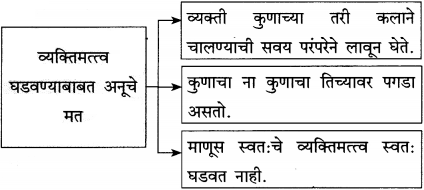
प्रश्न 2.

उत्तर :

3. टॅक्सी ड्रायव्हरने सांगितलेले पुढील पेशांतील साम्य लिहा :
प्रश्न 1.
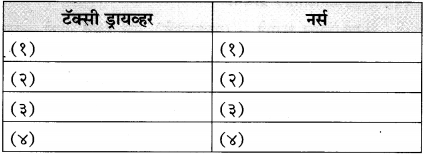
उत्तर :
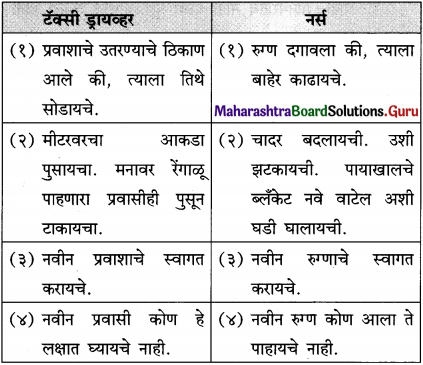
![]()
शोध लेखकांचा परिचय
लेखकांचे नाव :
व. पु. काळे
साहित्यिक व्यक्तिमत्त्व :
खूप लोकप्रिय कथालेखक, निबंधकार, नाटककार, कादंबरीकार, कथा–पटकथा लेखक, कथाकथनाचे शेकडो कार्यक्रम. कथा आकर्षकपणे सांगण्याची विलक्षण हातोटी, उत्कंठावर्धक कथालेखनाचे कौशल्य, ओघवती निवेदनशैली. ‘व. पु.चे विचार’ या शीर्षकाखाली त्यांच्या वाक्यांच्या संकलनांची निर्मिती. त्यांच्या कथेवरून चित्रपटाची निर्मिती.
ग्रंथसंपदा :
“ही वाट एकटीची’, ‘ठिकरी’, ‘लोंबकळणारी माणसं’, ‘पण माझ्या हातांनी’, ‘पेन सलामत तो’, ‘ब्रह्मदेवाचा बाप’ वगैरे अनेक कथासंग्रह प्रसिद्ध, ६० पेक्षा अधिक पुस्तके प्रसिद्ध. कादंबऱ्या, नभोनाटये प्रसिद्ध,
पुरस्कार–पारितोषिके :
महाराष्ट्र शासनाचा पुरस्कार, पु. भा. भावे पुरस्कार, फाय फाउंडेशनचा पुरस्कार.
शोध कथेचा गोषवारा
(१) पहिल्याच दृश्यात तीन पात्रे आहेत. ‘मी’ हा निवेदक, त्याची पत्नी मुक्ता आणि अनू. ‘मी’ हाच कथानिवेदक आहे. तोच कथा सांगत आहे, तो नायक आहे. पण केंद्रस्थानी अनू आहे. कथा तिच्याभोवती फिरते.
पहिलेच वाक्य उत्कंठावर्धक आहे, रहस्यमय आहे. पहिल्या वाक्यातच वाचक कथेत ओढला जातो आणि कथानकासोबत पुढे पुढे चालत राहतो. ही पात्रे कोण, त्यांचा एकमेकांशी संबंध काय? त्या तिघांमध्ये कोणता ताण निर्माण झाला? प्रसंग तरी कोणता? यांचा उलगडा होत नाही. त्यामुळे वाचकाच्या मनात उत्कंठा निर्माण होते.
(२) पुढच्या भागात अनू या पात्राची अधिक ओळख होते. मी हा निवेदक आबासाहेबांना भेटला. अन आबासाहेबांची मुलगी. त्या वेळी अनूची अधिक माहिती मिळाली. अनू ही स्वातंत्र्यप्रेमी. तिला स्वतंत्रपणे जगून पाहायचे होते. तिने आबासाहेबांकडून पाच वर्षे मागून घेतली. त्या पाच वर्षांत कोणीही तिला कशाहीबद्दल कोणताही जाब विचारायचा नाही. ती मुक्तपणे पाच वर्षे जगायला घराबाहेर पडली. तिने नर्सची नोकरी स्वीकारली. हॉस्पिटलच्या जवळच्या एका इमारतीत तिने भाड्याने घर घेतले.
(३) कथानिवेदक अनूला भेटण्यासाठी पत्नी मुक्तासोबत पुण्याहून मुंबईला आला, अनूच्या घरात उतरला तिथे त्याचे मित्र भिडे व भिडेवहिनी त्याला भेटायला आले. गप्पांत वेळ कसा गेला समजलेच नाही. रात्र झाली. भिडे टॅक्सीने घरी जाण्यासाठी उठले. निवेदकाने टॅक्सीवाल्याला देण्यासाठी पुरेसे सुटे पैसे देऊ केले. एक रुपया कमी पडला. टेबलावरच्या काचेखाली अनूने ठेवलेली एक रुपयाची नोट काढून ती भिड्यांना दिली. भिडे निघून गेले. इथेच खरा घोटाळा झाला.
![]()
(४) अनू घरी आल्यावर तिला हा प्रकार कळला. ती प्रचंड नाराज झाली, तिला संताप आला. एक रुपयाची नोट देऊन टाकल्यामुळे काहीएक नुकसान झाले, असे निवेदकाला मुळीच वाटत नव्हते. अनूला राग आला, हे त्याला मुळीच योग्य वाटत नव्हते. पण अनू हट्टाला पेटली होती. तिने खूप रात्र झाली होती तरी भिड्यांकडे जाण्याचा निर्णय घेतला. त्या दोघांना याचा धक्काच बसला.
(५) भिड्यांकडे गेल्यावर समजले की भिड्यांनी ती नोट टॅक्सी ड्रायव्हरला दिली. नंतर आढळले की टॅक्सी ड्रायव्हरने ती नोट हॉटेलवाल्याला दिली. अखेरीस ती नोट मिळाली, तेव्हा अनूने त्या नोटेमागचे रहस्य सांगितले.
(६) एके दिवशी अनूची ड्युटी लहान मुलांच्या वॉर्डमध्ये होती. त्या दिवशी आठनऊ वर्षांची मुलगी दाखल झाली. सगळ्यांनी तिची आशा सोडली होती. ब्लड ट्रॅन्स्फ्यूजनसाठी व सलायनसाठी तिच्या हातापायाला नळ्या लावल्या. ऑक्सिजनच्याही नळ्या लावल्या. तिला वाचवण्याची सगळ्यांची प्रचंड धडपड चालू होती. पण तिला मात्र सर्वत्र सुया टोचल्यामुळे वेदना होत होत्या. ती दिवसभर त्या नळ्या काढा असे विनवत होती. शेवटी अनूने पुढाकार घेतला. डॉक्टरांच्या परवानगीने तिने नळ्या काढल्या. त्या मुलीच्या वेदना थांबल्या. ती आनंदाने विसावली. थोड्याच अवधीत तिने अखेरचा श्वास घेतला. ती सुखाने मृत्यूच्या कुशीत शिरली. जाण्यापूर्वी तिने स्वत:च्या खाऊच्या पैशातला एक रुपया नर्सताईला – अनूला – भेट म्हणून दिला. त्याच रुपयाच्या नोटेचा शोध घेण्यासाठी धडपड चालू होती.
(७) इकडे टॅक्सी ड्रायव्हरचे उपकथानक चालू झाले होते. भिड्यांना घेऊन येणाऱ्या टॅक्सीखाली एक म्हातारा मनुष्य आला. टॅक्सी ड्रायव्हरची काहीही चूक नव्हती. त्याला विनाकारण शिक्षा होऊ नये म्हणून भिडे स्वतः हॉस्पिटल, पोलीस स्टेशन या ठिकाणी साक्षीसाठी धावले. शेवटी तो रुपया परत मिळवण्यासाठी टॅक्सी ड्रायव्हरने मदत केली. अनू आपली हकिगत सांगत होती, तेव्हा तो टॅक्सी ड्रायव्हर तिथे होताच. ती हकिगत ऐकून तो व्याकूळ झाला. अनूला नोट मिळाली. तिची समस्या संपली. तिचा शोध संपला, पण ड्रायव्हरचा शोध कधीच संपणार नव्हता. कारण त्याची मुलगी मरण पावली होती. अनूच्या वॉर्डमध्ये आलेली मुलगी तीच त्या ड्रायव्हरची मुलगी होती!
शोध शब्दार्थ
- विक्षिप्त – त–हेवाईक, विचित्र, लहरी.
- व्हेंटिलेटर – घरात हवा येण्याजाण्यासाठी दाराच्या वर तिरप्या पातळ पट्ट्या बसवलेली चौकट,
- अपरात्र – रात्रीचा खूप उशिराचा वेळ, रात्रीचा शेवट, उत्तररात्र.
शोध वाक्प्रचार व त्यांचे अर्थ
- पळ काढणे – पळून जाणे.
- जिव्हारी लागणे – खूप दुःख होणे, मन खूप व्यथित होणे.
- पगडा असणे – प्रभाव असणे.
- छाया पडलेली असणे – प्रतिबिंब भासणे, प्रभाव जाणवणे.
- निवारण करणे – (अडचणी, शंका इत्यादी) दूर करणे.
- चोरट्यासारखे होणे – अपराधी वाटणे.
- गळ घालणे – खूप विनवणी करणे.
- पाचारण करणे – बोलावून घेणे, हजर राहण्यास सांगणे.
- आवाज भरून येणे – दु:खाने किंवा खूप आनंदाने व्याकूळ होणे.
- बाराच्या भावात जाणे – नुकसान होणे, खूप अडचणी निर्माण होणे.
- (एखादयासाठी) प्रार्थना करणे/चालू असणे – (एखादयाचे) भले व्हावे अशी इच्छा व्यक्त करणे/भले व्हावे अशी विनवणी चालू असणे.
- धावाधाव करणे – चपळाईने प्रयत्न करणे.
Marathi 12th Textbook Guide Pdf Download भाग-३ साहित्यप्रकार



